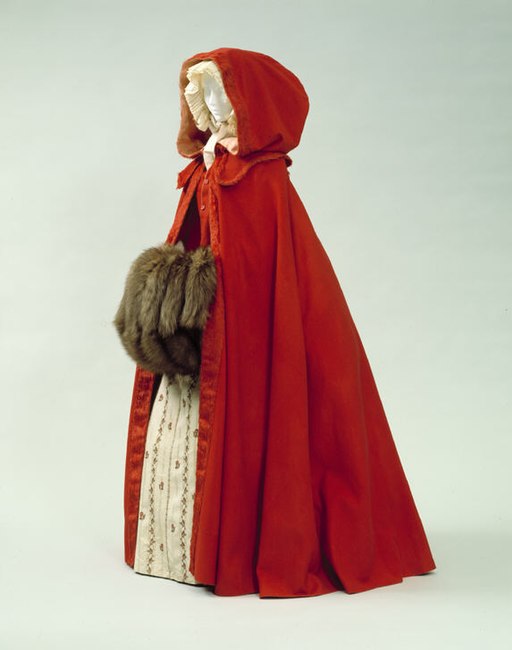This Cape form was a favorite item of dress in the American colonies from the time of the early settlers. This cape is called a “cardinal” because of its color.
It was made of a tightly woven wool cut on the bias and left with a raw edge along the hem. The hooded cape is gathered in a circular shape at the back to stand high without crushing the coiffure underneath.
By the late 18th century, cardinals could be bought ready-made in England. A cape is a sleeveless outer garment, which drapes the wearer’s back, arms, and chest, and fastens at the neck.
In fashion, the word “cape” usually refers to a shorter garment and “cloak” to a full-length version of the different types of clothing, though the two terms are used synonymously for full-length coverings.
Capes were standard in medieval Europe, especially when combined with a hood. Catholic clergy wears a cape for formal events and as liturgical vestment often highly decorated with elaborate embroidery.
Capes remain in regular use as rain-wear in various military units.
Cape
- Title: Cape
- Date: Last third 18th century
- Geography: England
- Materials: Wool
- Museum: Metropolitan Museum of Art – MET
Getting dressed in the 18th century
Getting dressed in the 18th century – working woman
Facts about Fashion
- The loincloth is the oldest item of clothing.
- The second oldest item of clothing is the skirt.
- Perfumes were used from the Ancient Egyptian Era for religious rituals, and the fashion has been thus since then.
- In ancient times, purple clothes were only worn by emperors, magistrates, and the aristocracy.
- The Ancient Romans wore yellow clothing on their wedding days.
- During the Renaissance, aristocratic women used to shave their eyebrows. Note Mona Lisa’s eyebrows.
- In the 15th century, being pregnant was popular for female portraits, so girls who were not pregnant used to put a small pillow under their clothes to create the illusion of the baby bump potential.
- Men wore high heels to ride horses up until 1740. It was thought that the heels helped them to ride horses better.
- The wig, which is commonly worn by judges today, derived from the days of King Louis XIII. The French King was balding and wore a massive wig to appear macho and dominant. He created the fashion for the European aristocracy.
- Napoleon had brass buttons sewn on the sleeves of his soldiers’ uniforms to discourage them from wiping their noses on their uniforms.
- Mark Twain invented and patented the bra-strap clasp.
- Up until the early 1910s, it was common for little boys to wear dresses until they were around five years old.
- Before Queen Victoria’s white wedding, white was a color traditionally associated with mourning.
- In 1909, the U.S. Navy banned naked lady tattoos on a service member’s arms. To join the Navy, men had to have clothes tattooed on their nude bodies.
- The famous Lacoste crocodile symbol was created in 1933 and was the first designer logo ever.
- In the United States, on average, each person owns seven pairs of jeans.
MET American Wing Collection
- “Washington Crossing the Delaware” by Emanuel Leutze
- “Portrait of Madame X” by John Singer Sargent
- “Mother and Child” by Mary Cassatt
- “Fur Traders Descending the Missouri” by George Caleb Bingham
- “The Gulf Stream” by Winslow Homer
MET European Sculpture and Decorative Arts Collection
- “Hercules the Archer” by Antoine Bourdelle
- “Orpheus and Eurydice” by Auguste Rodin
- “Perseus with the Head of Medusa” by Antonio Canova
MET Drawings and Prints Collection
- Album of Tournaments and Parades in Nuremberg
- “Canvassing for Votes” by William Hogarth
- “Christ and the Woman of Samaria” by Rembrandt
MET Costume Institute Collection
- Bodice
- Cardinal Cape
- Doublet
MET Photograph Collection
- Loie Fuller Dancing
- Sala Delle Statue, Vatican
- Gardner’s Photographic Sketchbook of the War
MET Musical Instrument Collection
- Ming-Dynasty Pipa
- Grand Piano
- Bass Fluegel Horn in B-flat
Getting Dressed in the 18th Century – Working Women in Summer
What would an 18th-century woman have kept in her pockets?
18th Century Cardinal Costume
~~~
“Fashions fade, style is eternal.”
– Yves Saint Laurent
~~~
Photo Credit: Metropolitan Museum of Art [CC0], via Wikimedia Commons
Popular this Week








 Sponsor your Favorite Page
Sponsor your Favorite Page SEARCH Search for: Search Follow UsJoin – The JOM Membership Program
Sponsor a Masterpiece with YOUR NAME CHOICE for $5
Share this:
- Tweet

